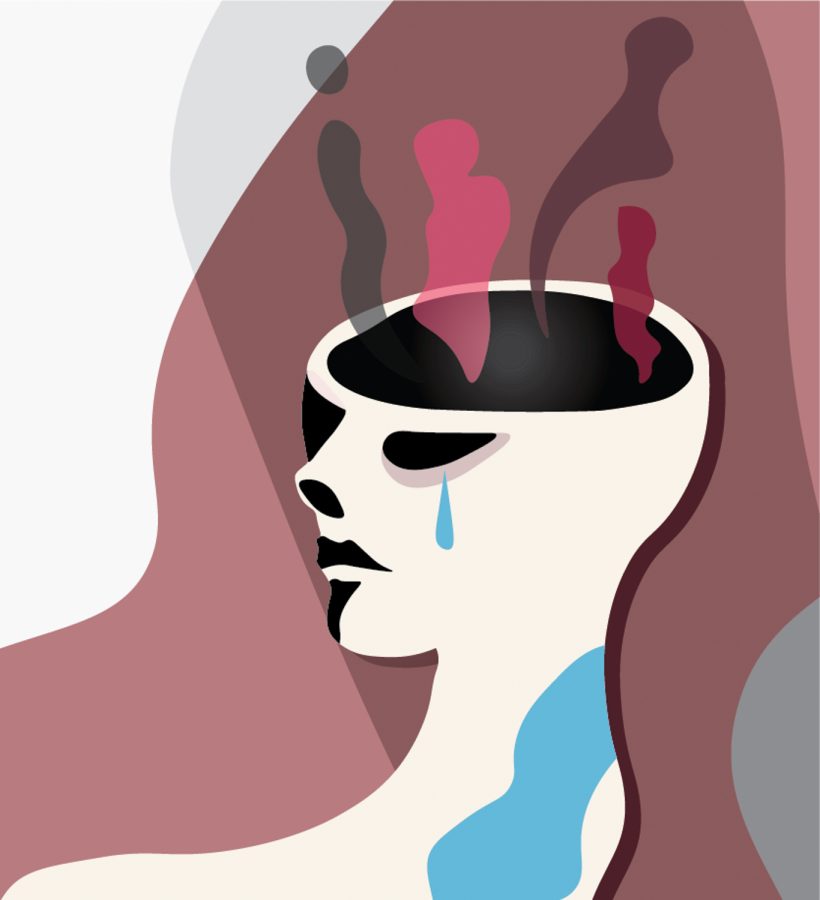Experts offer stress management tips leading into finals
Students should set routines to feel control, be aware of resources
Multiple factors can contribute to developing a mental health condition, including predispositions and additional stressors.
December 3, 2021
Effective coping strategies can help students manage the stress of school, especially with finals week approaching.
This is a crucial time for students, as 75 percent of all lifetime mental health conditions begin by age 24, according to the National Alliance on Mental Illness.
When your mental health is impacting other parts of life negatively, that is when it becomes an issue, said Sylvia Rangel-van Breda Vriesman, WSU Tri-Cities student wellness coordinator and counselor.
How mental health problems develop
There are multiple factors that contribute to someone developing a condition like an anxiety disorder, but it tends to be a combination of some predisposition and additional stressors, said Alexander Spradlin, scholarly assistant professor of psychology.
About 86 percent of WSU students felt overwhelmed, and an additional 64 percent expressed they felt very lonely, according to a 2018 National College Health Assessment.
Loneliness is a major negative contributor to medical and health-related conditions, including substance use and abuse, Spradlin said.
“Fifty-three percent of college students reported they are lonely at any given time,” Rangel-van Breda Vriesman said. “That’s about one in two students who are stepping on campus and feeling isolated.”
Loneliness is also a risk factor for suicidal ideation — one in four college students have contemplated suicide, according to the Centers for Disease Control and Prevention.
The issue is not black or white, Spradlin said. With mental health in particular, labels range from mild to severe rather than simply having a condition or not. However, If someone’s feelings are getting in the way of engaging in normal, everyday behaviors, that is when things can become problematic.
Identifying the issue
It can be easy to overlook feelings of distress if students do not know what that looks like, Rangel-van Breda Vriesman said. Students should take note of behavior that might have changed or be out of the ordinary.
Telltale distress signs
Persistent sadness or withdrawal is a big indicator that something is not right, Rangel-van Breda Vriesman said. This can look like no longer participating in activities they once enjoyed and isolation from friends and family.
“This is a bigger picture of ‘I wake up feeling sad or hopeless, and it lasts all day. There’s nothing that makes it go away,’” she said.
A lot of people cite having trouble coping with everyday stressors or challenges when under distress, Rangel-van Breda Vriesman said. Students may observe they overreact to situations and are more frequently or easily irritated, angry or aggressive.
Another indicator that something may be going wrong is behavior that is considered severe, out of control or risk-taking. This could present as repeatedly and excessively using drugs or alcohol, she said.
This behavior is also becoming more common, with 13 percent of Americans reporting they started or increased substance use as a way of coping with stress or emotions related to COVID-19, according to the CDC.
Change in appearance, which may present as neglecting certain self-care activities or hygiene, is another indicator. This can also include not eating, throwing up or using laxatives, which leads to weight fluctuations, Rangel-van Breda Vriesman said.
About 12 percent of college students nationwide also have a co-occurring eating disorder in addition to another mental health condition, she said.
“It is a slippery slope, substance abuse and eating disorders. It can really snowball very quickly and get into things that are a lot more severe,” Rangel-van Breda Vriesman said.
Other indicators are drastic changes in mood, behavior, personality or sleeping habits, she said. These changes in sleep may include either hypersomnia — sleeping more than usual and still feeling tired — or the inverse, which is insomnia.
Disparaging comments such as saying one is “worthless,” wondering the point of life and not wanting to wake up can lead to even more severe actions like trying to harm oneself or planning to do so, Rangel-van Breda Vriesman said.
“If you’re having any thoughts of hurting yourself or other people, that’s a clear indicator to seek some help to talk to somebody,” Spradlin said.
Other signs include difficulty concentrating or staying still, worries or fears that interfere with daily activities, experiencing or believing things that are not real and overwhelming fear without cause or reason, Rangel-van Breda Vriesman said.
You are not alone
Within Washington, one in five adults experience a mental health issue each year, according to NAMI.
The pandemic exacerbated these issues. Forty percent of college students have reported moderate to severe psychological distress since the COVID-19 pandemic began, according to a study by the National Institute of Mental Health Active Minds.
What to do
Learn healthy coping methods that work for you, and do not be afraid to seek help, Spradlin said.
This starts with identifying the things that exacerbate stress and what reduces or protects against stress. Students should also be aware of the mental health resources available, he said.
Avoid a one-size-fits-all approach, Spradlin said. Instead, employ a mix of different coping strategies because not every strategy is going to work for every kind of situation. For example, some issues can be addressed directly, while others may require more emotion-focused coping.
More coping strategies increase the likelihood of having better outcomes, he said.
Although everyone is different, there are some basics that tend to work for a lot of people, Spradlin said. These include exercise, water, good nutrition and a regular sleep schedule.
Another major cause for stress and anxiety is uncertainty about the future, Rangel-van Breda Vriesman said. In the era of COVID-19, this is becoming more prevalent.
There are things in life that are simply out of one’s control. Instead, people should focus on the things in life that they do have control over, she said. This may include developing a routine for each day or using a planner to organize one’s schedule.
“Because of COVID and Zoom learning, setting a new routine kind of went out the window for a lot of people. Providing structure in the day is helpful to feel in control,” Rangel-van Breda Vriesman said.
Practicing gratitude and connecting with moments of joy can also be helpful in these uncertain times, she said.
Avoid using substances to cope, as these can exacerbate mental health symptoms. Spradlin said that while some drugs may work in the short term, people can quickly become dependent on them or have withdrawal syndrome.
Take advantage of resources
“I encourage students to be proactive about their mental health and well being,” Rangel-van Breda Vriesman said. “Empowering them to know where to go before they have an issue.”
Receiving help from family and friends is helpful for many, but support can also be found in other places:
Cougar Health Services offers free Counseling and Psychological Services to Pullman students.
The 24/7 National Suicide Prevention Lifeline can be reached at 800-273-8255.
The Jed Foundation has a crisis text line; text START to 741-741.
WSU has a Stress Management Text Program; text @STRESS to 844-486-0046 to opt-in to receive weekly stress management tips via text message.
Symptoms can also be managed through mindfulness apps like Headspace, Calm, Aloe Bud and Chopra.










